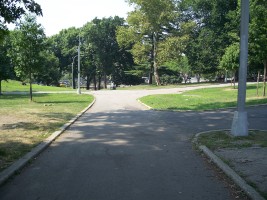Port Morris Branch: Saint Mary's Park
The "highlight" of the Port Morris Branch was a tunnel under St. Mary's Park. It was not easily (or legally) accessible from the street so I don't have any pictures from inside. But I would imagine that if there isn't too much standing water in it, there probably are street people calling it home. It would doubtless be a stimulating walk.
St. Mary's Park was part of the estate of Jonas Bronck (1600-1643), for whom the Bronx is named. The land was later owned by Gouverneur Morris (1752-1816). The land was annexed by the City of New York in 1874 and following the efforts of journalist John Mullaly (1835-1915), the 1884 New Parks Act lead to the purchase of land between 1888 and 1890 for six parks in the Bronx. This 35-acre park was named after the Episcopal church that stood three blocks to the west until 1959.
The tunnel under the park was dug in 1903 as part of a grade-crossing elimination project for the entire Port Morris Branch.
Starting in the early 1970s, the US Department of Housing and Urban Development gave the Boston real estate company Continental Wingate a number of crumbling buildings here in the South Bronx along with mortgage guarantees, tax breaks and federal subsidies. This early example of privatization was intended to help improve the quality of life here, but, instead, the company became the area's biggest slumlord. In the mid 1990s, tenants organized to convince HUD to investigate the company. The probe found rampant negligence and fraud, compounded by HUD secretary Andrew Cuomo apparently looking the other way while the government and residents were fleeced by the company's owner, Gerald Schuster, who was a major Democratic donor. Once Continental Wingate was out of the picture, management was taken over by the Diego Beekman Mutual Housing Association, a non-profit entity run by tenants and community leaders.

Trench running south from Jackson Avenue

Trench wall and debris - 143rd Street at Jackson Avenue

Trench coming from the south into St. Mary's Park

Jackson Avenue running over the southern portal of the tunnel

Jackson Avenue running over the southern portal of the tunnel

Where the tunnel runs off the southeast end of St. Mary's Park

St. Mary's Park baseball field

Southeast corner of St. Mary's Park

Redeveloped low-rise multi-family dwellings south of the park

A southern gate entrance to the park

Exposed rock outcroppings in the center of the park

Walkway through the park

Playground in the northwest part of the park

Pathway into the park over the tunnel

Tunnel crossing under East 149th Street at the northwest corner of the park

Tunnel crossing under a vacant lot at the corner of 149th Street and St. Ann's Avenue

Parks Department district headquarters at the northwest corner of the park

I.S. 162 - just east of the tunnel

St. Mary's Park Tunnel passing under St. Ann's Avenue

Meager fencing on the north portal of the St. Mary's Park tunnel

Short section of trench between Westchester Ave. and the St. Mary's Park tunnel

Sign in front of a vacant lot

Diego Beekman Mutual Housing Association

Diego Beekman Mutual Housing Association

Vacant lot - St. Ann's Avenue at 142nd Street

Apartment buildings on East 141st Street

Closed deli in an apartment building on East 141st Street

Old rowhouses on Jackson Avenue north of 141st Street

New rowhouses on Jackson Avenue north of 142nd Street

Southern portal of St. Mary's Park Tunnel
40.809358, -73.910447

Southern portal of the St. Mary's Park Tunnel (video)

Trench looking south from Jackson Avenue

Trench looking south from Jackson Avenue

Jackson Avenue Bridge

Jackson Avenue side of Saint Mary's Park

Tunnel path through Saint Mary's Park
40.809786, -73.910628

Recreation area over the tunnel
40.811187, -73.910905

London Plane Trees

Recreation area (video)

On a hill in Saint Mary's Park looking north towards Melrose
40.812942, -73.911747

Saint Mary's Park

149th Street Bridge over the tunnel
40.814147, -73.912460

Fresca Pizza, 560 East 149th Street
40.8141487033275,-73.9133895124758,2000123

I-M-Sorri only pickup or deliveri (sic)

40th Precinct Stationhouse
40.814676, -73.913070

40th Precinct Stationhouse

40th Precinct Stationhouse

40th Precinct Stationhouse

40th Precinct Stationhouse

40th Precinct Stationhouse

40th Precinct Stationhouse

Northern portal of St. Mary's Park Tunnel
40.815139, -73.912861